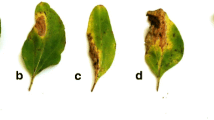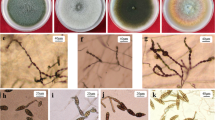Abstract
Nine Alternaria species have been reported to be associated with sunflower leaf blight worldwide, and A. helianthi has been recognized as the most prevalent and damaging species. However, the population structure of Alternaria species causing leaf blight of sunflower in China had not been examined thoroughly prior to this study. During 2010 to 2013, a total of 272 Alternaria isolates were obtained from infected sunflower leaves in 11 provinces, autonomous regions, and municipalities of China. Based on morphological traits and sequence analyses of the internal transcribed spacer (ITS) regions of ribosomal DNA (rDNA) and the partial coding sequences of the histone 3 gene, 227 (83.5 %) isolates were identified as belonging to Alternaria tenuissima, the remainder 45 isolates were grouped to A. alternata (16.5 %). Compared with the ITS regions of rDNA, sequence analyses of the partial coding sequences of histone 3 gene displayed a critical role in discrimination of the small-spored Alternaria species. Phylogenetic analysis of the partial coding sequence of histone 3 gene clearly divided the representative Alternaria isolates into two main clades, A. tenuissima and A. alternata. The pathogenicity of A. tenuissima and A. alternata on detached leaves of sunflower cv. Gankui No.2 did not significantly differ between the two species or among isolates from different geographical origins. Our results indicate that the population structure of Alternaria species associated with sunflower leaf blight differed from that reported previously in China since A. helianthi was not found in this study. In addition, this is the first report about A. tenuissima causing leaf blight on sunflower in China.





Similar content being viewed by others
References
Adachi, Y., Watanabe, H., Tanabe, K., Doke, N., Nishimura, S., & Tsuge, T. (1993). Nuclear ribosomal DNA as a probe for genetic variability in the Japanese pear pathotype of Alternaria alternata. Applied and Environmental Microbiology, 59, 3197–3205.
Allen, S. J., Brown, J. F., & Kochman, J. K. (1983). Effects of leaf age, host growth stage, leaf injury, and pollen on the infection of sunflower by Alternaria helianthi. Phytopathology, 73, 896–898.
Andersen, B., Kroger, E., & Roberts, R. G. (2001). Chemical and morphological segregation of Alternaria alternata, A. gaisen and A. longipes. Mycological Research, 105, 291–299.
Balasubrahmanyam, N., & Kolte, S. J. (1980). Effect of Alternaria blight on yield components, oil content and seed quality of sunflower. Indian Journal of Agricultural Sciences, 50, 701–706.
Basak, A. B., & Mridha, A. U. (1985). Alternaria tenuissima: a new fungal pathogen of leaf blight of sunflower. Bangladesh Journal of Agriculture, 10, 71–73.
Bensassi, F., Zid, M., Rhouma, A., Bacha, H., & Hajlaoui, M. R. (2009). First report of Alternaria species associated with black point of wheat in Tunisia. Annals of Microbiology, 59, 465–467.
Carson, M. L. (1987). Effects of two foliar pathogens on seed yield of sunflower. Plant Disease, 71, 549–551.
Ge, Y. B., Chen, B. D., Mao, X. H., & Jia, X. P. (2013). Genetics and correlation analysis of economic traits in oil sunflower (Helianthus annuus L.). Chinese Journal of Oil Crop Sciences, 35, 515–523. In Chinese.
Glass, N. L., & Donaldson, G. C. (1995). Development of primer sets designed for use with the PCR to amplify conserved genes from filamentous ascomycetes. Applied and Environmental Microbiology, 61, 1323–1330.
Johnson, R. D., Johnson, L., Kohmoto, K., Otani, H., Lane, C. R., & Kodama, M. (2000). A polymerase chain reaction-based method to specifically detect Alternaria alternata apple pathotype (A. mali), the causal agent of Alternaria blotch of apple. Phytopathology, 90, 973–976.
Khodaei, S., & Arzanlou, M. (2013). Morphology, phylogeny and pathogenicity of Alternaria species, involved in leaf spot disease of sunflower in northern Iran. Archives of Phytopathology and Plant Protection, 46, 2224–2234.
Kusaba, M., & Tsuge, T. (1995). Phologeny of Alternaria fungi known to produce host-specific toxins on the basis of variation in internal transcribed spacers of ribosomal DNA. Current Genetics, 28, 491–498.
Li, Y., Zhang, D., Xu, W., Wu, Z., Guo, M., & Cao, A. (2011). Alternaria tenuissima causing leaf spot and fruit rot on pepper (Capsicum annuum): first report in China. New Disease Reports, 24, 3.
Liu, L., & Li, X. (1988). The geographical distribution of sunflower diseases in China. Plant Pathology, 37, 470–474.
Madania, A., Altawil, M., Naffaa, W., Volker, P. H., & Hawat, M. (2013). Morphological and molecular characterization of Fusarium isolated from maize in Syria. Journal of Phytopathology. doi:10.1111/jph.12085.
Narasimhan, R. G., & Rajagopalan, K. (1979). Effect of different liquid media on growth and sporulation of Alternaria helianthicola Rao and Raj causing a new leaf spot of sunflower. Science and Culture, 45, 243–244.
Prathuangwong, S., Kao, S. W., Sommartya, T., & Sinchaisri, P. (1991). Role of four Alternaria spp. causing leaf and stem blight of sunflower in Thailand and their chemical controls. The Kasetsart Journal, 25, 112–124.
Pryor, B. M., & Michailides, T. J. (2002). Morphological, pathogenic, and molecular characterization of Alternaria isolates associated with Alternaria late blight of pistachio. Phytopathology, 92, 406–416.
Rang, J. C., Crous, P. W., Mchau, G. R., Serdani, M., & Song, S. M. (2002). Phylogenetic analysis of Alternaria spp. associated with apple core rot and citrus black rot in South Africa. Mycological Research, 106, 1151–1162.
Reddy, P. C., & Gupta, B. M. (1977). Disease loss appraisal due to leaf blight of sunflower indicated by Alternaria helianthi. Indian Phytopathology, 30, 569–570.
Santha, L. P. M., Sujatha, M., & Chander, R. S. (2009). Analysis of cultural and genetic diversity in Alternaria helianthi and determination of pathogenic variability using wild Helianthus species. Journal of Phytopathology, 157, 609–617.
Shahnaz, D., & Ghaffar, A. (1991). Detection of the seedborne mycoflora of sunflower. Pakistan Journal of Botany, 23, 173–178.
Simmons, E. G. (2007). Alternaria: an identification manual. Utrecht: CBS.
Thompson, J. D., Higgins, D. G., & Gibson, T. J. (1994). Clustal W: improving the sensitivity of progressive multiple sequence alignment through sequence weighting, position-specific gap penalties and weight matrix choice. Nucleic Acids Research, 22, 4673–4680.
Udayashankar, A. C., Nayaka, S. C., Archana, B., Anjana, G., Niranjana, S. R., Mortensen, C. N., et al. (2012). Specific PCR-based detection of Alternaria helianthi: the cause of blight and leaf spot in sunflower. Archives of Microbiology, 194, 923–932.
Viswanathan, R. (2012). Seed mycoflora composition in sunflower. Indian Phytopathology, 49, 286–289.
White, T. J., Bruns, T., Lee, S. J. W. T., & Taylor, J. W. (1990). Amplification and direct sequencing of fungal ribosomal RNA genes for phylogenetics. PCR Protocols A Guide to Methods and Applications, 18, 315–322.
Yang, W. X., Liu, F., Zhang, N., Ren, X. D., & Liu, D. Q. (2013). First report of Alternaria alternata causing blight on Zanthoxylum piperitum in China. Plant Disease, 97, 840–840.
Yu, S. H. (2000). Three Alternaria species pathogenic to sunflower. The Plant Pathology Journal, 16, 331–334.
Yu, L., Zhang, L. H., Li, C., & Guan, C. J. (1996). Alternaria helianthi on sunflower was identified and compared its forms with its closed species. Journal of Jilin Agricultural University, 18, 22–24 (In Chinese).
Zhao, Y. Z., & Liu, Z. H. (2012). First report of black spot disease caused by Alternaria alternata on cherry fruits in China. Plant Disease, 96, 1580–1580.
Acknowledgments
This work was supported by Program for Changjiang Scholars and Innovative Research Team in University (No. IRT1042). Mention of trade names or commercial products in this report is solely for the purpose of providing specific information and does not imply recommendation or endorsement.
Author information
Authors and Affiliations
Corresponding author
Additional information
The first and second authors contributed equally to this work
Rights and permissions
About this article
Cite this article
Wang, T., Zhao, J., Sun, P. et al. Characterization of Alternaria species associated with leaf blight of sunflower in China. Eur J Plant Pathol 140, 301–315 (2014). https://doi.org/10.1007/s10658-014-0464-z
Accepted:
Published:
Issue Date:
DOI: https://doi.org/10.1007/s10658-014-0464-z




